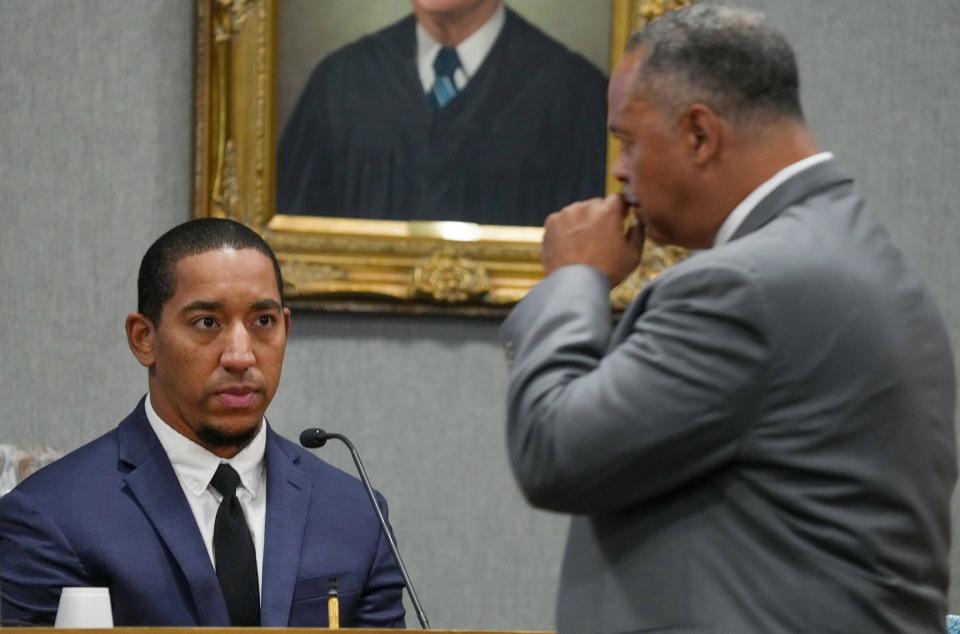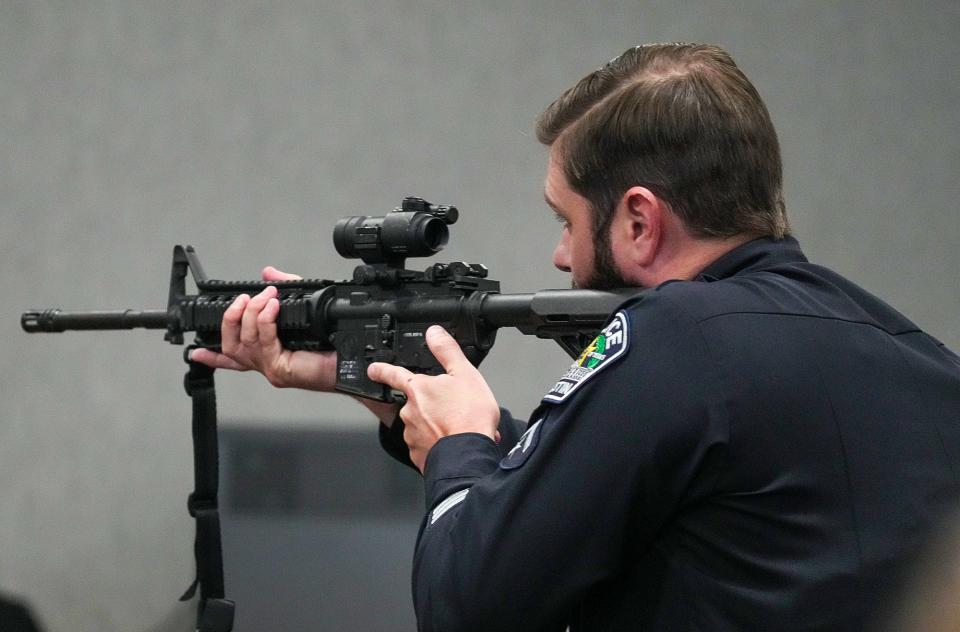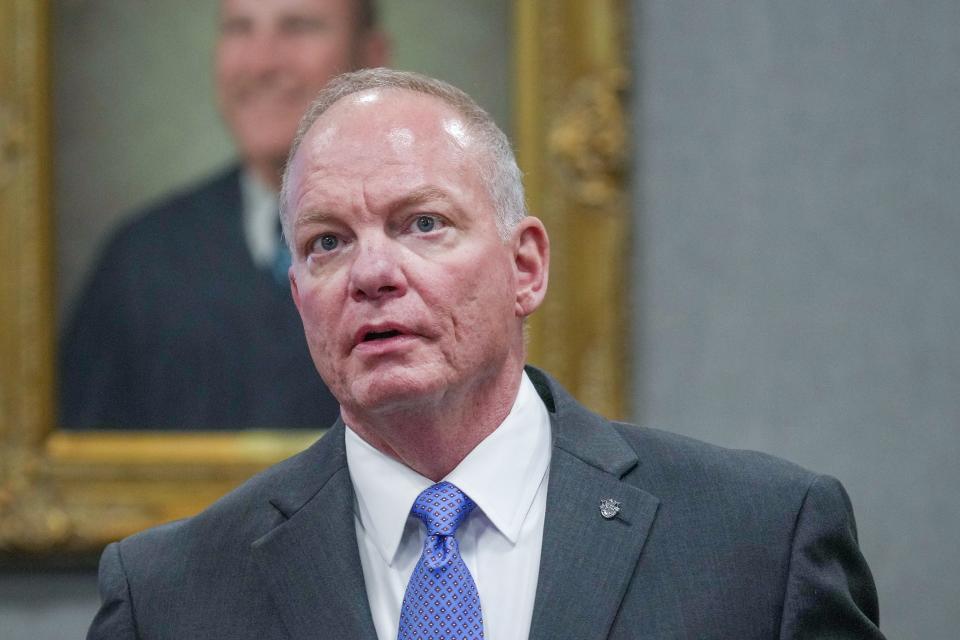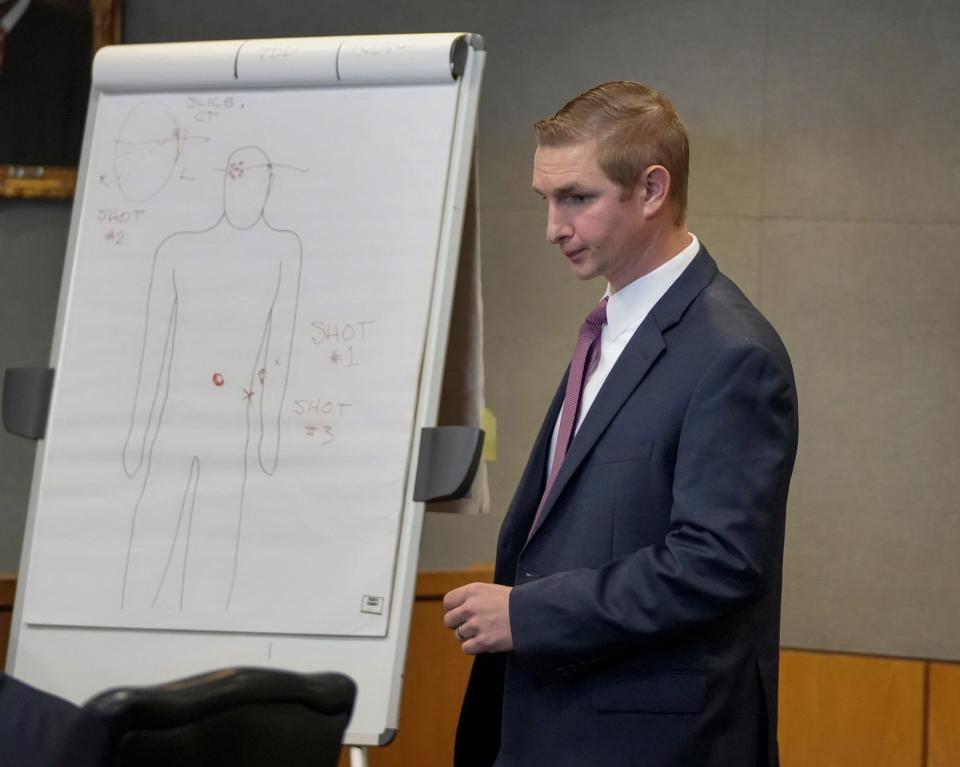Austin police officer trial: Did detective influence officer statements in Taylor case?
Austin police officer Christopher Taylor, on trial for the April 2020 shooting death of Michael Ramos, is believed to be the first Austin police officer charged with murder for an on-duty use of force.
The trial began on Oct. 23 and is expected to run until early next week. Prosecutors from the Travis County district attorney’s office have argued that Taylor’s use of lethal force was unjustified and in defiance of police protocol.
Defense attorneys began their presentation of evidence on Wednesday.
Check back for continued updates on the trial against Taylor this week.
Read about the first day of the trial: Trial of Austin police officer Christopher Taylor, accused of murdering Mike Ramos, begins
Former APD officer says statement did not accurately reflect her interview about night of Ramos' death
The defense called Katrina Ratcliff, who was one of the officers who responded to the 911 call that led to Taylor shooting and killing Ramos. Ratcliff has since left the Police Department.
Assistant District Attorney Josh Smalley drew attention to the statement that Ratcliff gave the Special Investigations Unit after the shooting. Prosecutors played footage of Ratcliff’s interview with Angel Polansky, then an SIU detective.
In it, Ratcliff can be heard saying, “Officer Darrell Cantu-Harkless and I were in a spot that we could have gotten ran over if he had proceeded in our direction.”
The final statement, which Polansky typed out during the interview, omitted the phrase “if he had proceeded in our direction.”
Ratcliff acknowledged that the SIU statement did not completely reflect what she said during the interview.
Did the Special Investigations Unit influence officer statements?
Throughout the trial, prosecutors have questioned how the Austin Police Department’s Special Investigations Unit conducts criminal inquiries into officer-involved shootings. Prosecutors have drawn attention to statements that officers present during Ramos’ death gave to the SIU.
Officer Darrell Cantu-Harkless, who was closest to Ramos’ car, has faced considerable scrutiny on the witness stand.
On Friday morning, prosecutors presented a transcript of the SIU interview of Cantu-Harkless in the wake of the Ramos shooting.
The transcript showed that the SIU detective who conducted the interview, Andrew Wunderlich, was the first to mention that Ramos could have used his Prius against officers.
In order to argue that Taylor shot Ramos in self-defense, his attorneys must prove that Ramos intended to use his vehicle as a deadly weapon.
Other officers present at the scene have echoed this sentiment on the witness stand, but prosecutors have tried to dispute that they were primarily concerned about being struck by the vehicle.
Defense attorney Doug O’Connell dismissed concerns that the SIU might have impacted Cantu-Harkless’ statement.
O’Connell asked Cantu-Harkless if he felt that Wunderlich “put words in (his) mouth.”
Cantu-Harkless said that he did not.
Prosecution, defense dispute whether Michael Ramos’ car was directed at officers
Defense lawyers called back to the witness stand some of the Austin police officers who responded, alongside Taylor, to the 911 call that ended in Ramos’ death.
On Thursday, officers Benjamin Hart and Darrell Cantu-Harkless testified for the second time. In a pivotal moment last week, Hart conceded that, when Ramos’ vehicle moved forward, he did not believe that his life was in danger.
Defense attorney Doug O'Connell asked Cantu-Harkless to walk the jury through, for the second time, his experience of the moments before Taylor shot Ramos. On Thursday, Cantu-Harkless said that he was afraid that Ramos would drive directly toward him.
Prosecutors have argued that Ramos was driving to his right and intended to go toward the north end of the parking lot. They have tried to establish that Ramos' Prius could have fit through the trees separating the parking lot from the street. Defense attorneys have pushed back against this assertion, arguing that the only way out of the parking lot was either "through or around the officers."
Precisely in what direction Ramos was driving may be important to jurors' determination of whether Taylor's decision to shoot was justified.

Taylor took firearms training courses within two months of both Ramos, DeSilva shootings
The defense’s first witness was the Austin police officer who taught firearms courses to Taylor. Jonathan Slayton testified that Taylor took both 40- and 20-hour courses in rifle handling.
Taylor took the 40-hour introductory course in July 2019. Later that month, Taylor was involved in the shooting death of Mauris DeSilva, for which he has been charged with first-degree murder.
Taylor took the 20-hour course — intended for officers with more experience with rifles — in February 2020, less than two months before Ramos’ death.
Prosecutors have been barred from mentioning Taylor’s involvement in DeSilva’s death.

Defense says case comes down to whether Christopher Taylor perceived a threat
In his opening statement on Wednesday afternoon, Taylor’s attorney Doug O’Connell told the jury that the case before them is about one thing: whether "Taylor perceived a deadly threat in the seconds before taking his action.”
The defense’s opening statement has been highly anticipated, as the lawyers elected not to give one on the first day of trial. The courtroom gallery was packed on Wednesday.
O’Connell told jurors that prosecutors had left out crucial pieces of information in their presentation of evidence.
He promised jurors that the defense would provide them with officer and expert testimony that would show that Taylor's actions were "reasonable" based on what he'd perceived.

How might 'human perception' differ from body-worn camera footage? Policing expert weighs in.
On Wednesday morning, policing expert and law professor Seth Stoughton took the stand and discussed how video footage — such as from a body-worn camera — can differ from “human perception.” He said that movement on video can look “much more intense” than actual movement is.
“The camera sees both more than and less than our human eye,” he said.

Throughout the trial, prosecutors have played footage from various body-worn and patrol vehicle cameras to show that, when Taylor fired at Ramos, Ramos’ vehicle was turning away from officers.
Stoughton said that while body-worn camera can’t capture the full breadth of human perception, it’s still useful in identifying all the information available to the officer at the time.
“It could help us identify whether the officer’s subjective perceptions … were reasonable and professionally appropriate,” Stoughton said.
This article originally appeared on Austin American-Statesman: Christopher Taylor trial updates: Did detective sway police statements?

